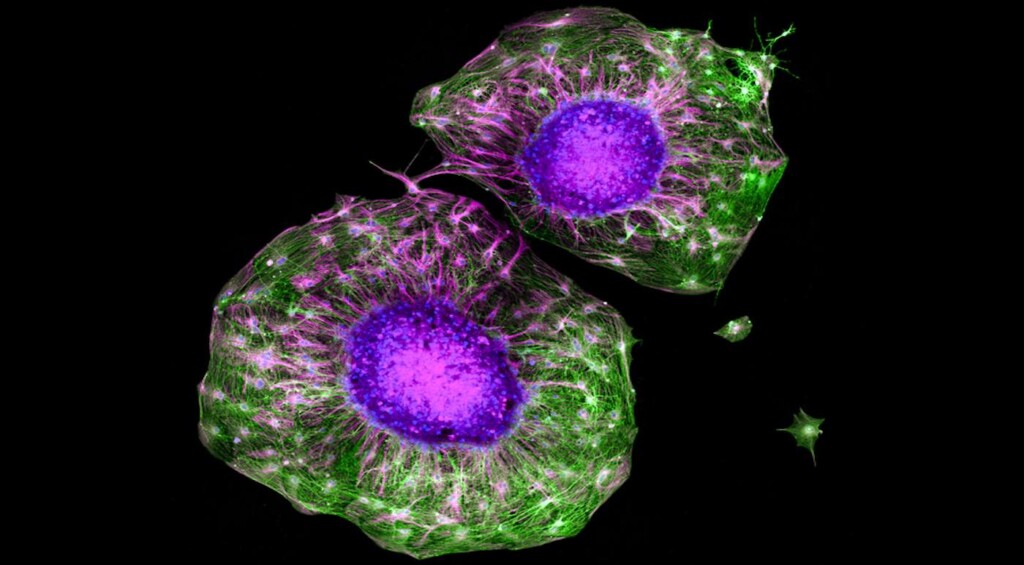
There’s no doubt that exercise does a body good—strengthening muscles and bolstering our bones, blood vessels, and immune system—but now, MIT engineers have found that it also has benefits at the level of individual neurons.
They observed that when muscles contract during exercise, they release a soup of biochemical signals called myokines. In the presence of these muscle-generated signals, neurons grew four times farther compared to neurons that were not exposed to myokines.
These cellular-level experiments suggest that exercise can have a significant biochemical effect on nerve growth. Surprisingly, the researchers also found that neurons respond not only to the biochemical signals of exercise but also to its physical impacts.
While previous studies have indicated a potential biochemical link between muscle activity and nerve growth, this is the first to show that physical effects can be just as important—and the results shed light on the connection between muscles and nerves during exercise, and could inform exercise-related therapies for repairing nerves.
“Now that we know this muscle-nerve crosstalk exists, it can be useful for treating things like nerve injury, where communication between nerve and muscle is cut off,” says Ritu Raman, Assistant Professor of Mechanical Engineering at MIT and senior author of the study. “Maybe if we stimulate the muscle, we could encourage the nerve to heal, and restore mobility to those who have lost it due to traumatic injury or neurodegenerative diseases.”
“Exercise as medicine”
In 2023, Raman and her colleagues reported that they could restore mobility in mice that had experienced a traumatic muscle injury, by first implanting muscle tissue at the site of injury, then exercising the new tissue by stimulating it repeatedly with light. Over time, they found that the exercised graft helped mice to regain their motor function, reaching activity levels comparable to those of healthy mice.
When the researchers analyzed the graft itself, it appeared that regular exercise stimulated the grafted muscle to produce certain biochemical signals that are known to promote nerve and blood vessel growth.
POPULAR: New Study of 10,000+ People Revealed Regular Physical Activity Is Linked to Larger Healthier Brains

“We always think that nerves control muscle, but we don’t think of muscles talking back to nerves,” Raman says. “So, we started to think stimulating muscle was encouraging nerve growth. And people replied that maybe that’s the case, but there’s hundreds of other cell types in an animal, and it’s really hard to prove that the nerve is growing more because of the muscle, rather than the immune system or something else playing a role.”
In their new study published in the journal Advanced Healthcare Materials, the team set out to determine whether exercising muscles has direct effect on how nerves grow, by focusing solely on muscle and nerve tissue.
The team genetically modified the muscle to contract in response to light. With this modification, the team could flash a light repeatedly, causing the muscle to squeeze in response, in a way that mimicked the act of exercise. Raman previously developed a novel gel mat on which to grow and exercise muscle tissue. The gel’s properties are such that it can support muscle tissue and prevent it from peeling away as the researchers stimulated the muscle to exercise.
GROWS YOUR BRAIN: New Study of 10,000+ People Revealed Regular Physical Activity Is Linked to Larger Healthier Brains
The team then collected samples of the surrounding solution in which the muscle tissue was exercised, thinking that the solution should hold myokines, including growth factors, RNA, and a mix of other proteins.
“Muscles are pretty much always secreting myokines, but when you exercise them, they make more,” Raman says.
The researchers grew the neurons from stem cells derived from mice. As with the muscle tissue, the neurons were grown on a similar gel mat. After the neurons were exposed to the myokine mixture, the team observed that they quickly began to grow—four times faster than neurons that did not receive the biochemical solution.
“They grow much farther and faster, and the effect is pretty immediate,” Raman notes.
For a closer look at how neurons changed in response to the exercise-induced myokines, the team ran a genetic analysis, extracting RNA from the neurons to see whether the myokines induced any change in the expression of certain neuronal genes.
ALSO GREAT FOR DEPRESSION AND THE HEART: Exercise Cuts Heart Disease Risk by 23% With Benefits Doubling for Those With Depression
“We saw that many of the genes that up-regulated in the exercise-stimulated neurons were not only related to neuron growth, but also neuron maturation, how well they talk to muscles and other nerves, and how mature the axons are,” Raman says. “Exercise seems to impact not just neuron growth but also how mature and well-functioning they are.”
The results suggest that biochemical effects of exercise can promote neuron growth. Then the group wondered: Could exercise’s purely physical impacts have a similar benefit?
“Neurons are physically attached to muscles, so they are also stretching and moving with the muscle,” Raman says. “We also wanted to see, even in the absence of biochemical cues from muscle, could we stretch the neurons back and forth, mimicking the mechanical forces (of exercise), and could that have an impact on growth as well?”
It turned out that both biochemical and physical effects of exercise are “equally important”.
GET WALKING: Millions Who Suffer Back Pain Can Ease Symptoms Simply by Walking More–For ‘Huge Benefits’
Now that the group has shown that exercising muscle can promote nerve growth at the cellular level, they plan to study how targeted muscle stimulation can be used to grow and heal damaged nerves, and restore mobility for people who are living with a neurodegenerative disease such as ALS.
“This is just our first step toward understanding and controlling exercise as medicine,” Raman says.
SHARE THE NEWS With Fitness Gurus On Social Media…




















